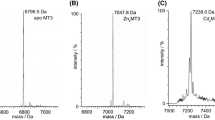Abstract
The binding abilities of silver(I) to mammalian MT 1 have been studied and compared with those of copper(I), recently reported [Bofill et al. (2001) J Biol Inorg Chem 6:408–417], with the aim of analyzing the suitability of Ag(I) as a Cu(I) probe in Cu–MT studies. The Zn/Ag replacement in recombinant mouse Zn7–MT 1 and corresponding Zn4-αMT 1 and Zn3-βMT 1 fragments, as well as the stepwise incorporation of Ag(I) to the corresponding apo-MTs, have been followed in parallel by various spectroscopic techniques including electronic absorption (UV–vis), circular dichroism (CD) and electrospray mass spectrometry coupled to capillary zone electrophoresis (CZE-ESI-MS). A comparative analysis of the sets of data obtained in the titration of Zn7–MT 1, Zn4–αMT 1 and Zn3-βMT 1 with AgClO4 at pH 7.5 and 2.5 has led to the reaction pathways followed during the incorporation of silver to these proteins under these specific conditions, disclosing unprecedented stoichiometries and structural features for the species formed. Thus, the Zn/Ag replacement in Zn7–MT 1 at pH 7.5 has revealed the subsequent formation of Ag4Zn5–MT, Ag7Zn3–MT, Ag8Zn3–MT, Ag10Zn2–MT, Ag12Zn1–MT, Ag x –MT, x=14–19, whose structure consists of two additive domains only if Zn(II) remains coordinated to the protein. A second structural role for Zn(II) has been deduced from the different folding found for the Ag x –MT species of the same stoichiometry formed at pH 7.5 or 2.5. Comparison of the binding features of Cu(I) and Ag(I) to the entire MT at pH 7.5 shows that, among all the Μ x Zn y –MT (0≤y<7) species found, only MI 4Zn5–MT [(Zn4)α(Μ4Zn1)β] and MI 7Zn3–MT [(Μ3Zn2)α(Μ4Zn1)β], which form during the first stages of the Zn(II)/M(I) metal replacement, show comparable 3D structures; thus, they are the only species where Ag(I) ions can be predicted to be an adequate probe for Cu(I).










Similar content being viewed by others
References
Bofill R, Capdevila M, Cols N, Atrian S, González-Duarte P (2001) J Biol Inorg Chem 6:408–417
Robbins AH, McRee DE, Williamson M, Collett SA, Xuong NH, Furey WF, Wang BC, Stout CD (1991) J Mol Biol 221:1269–1293
González-Duarte P (2003) In: McCleverty JA, Meyer TJ (eds) Comprehensive coordination chemistry II, vol 8. Pergamon, New York, in press
Li YJ, Weser U (1992) Inorg Chem 31:5526–5533
Narula SS, Mehra RK, Winge DR, Armitage IM (1991) J Am Chem Soc 113:9354–9358
Peterson CW, Narula SS, Armitage IM (1996) FEBS Lett 379:85–93
Bertini I, Hartman HJ, Klein T, Liu G, Luchinat C, Weser U (2000) Eur J Biochem 267:1008–1018
Narula SS, Winge DR, Armitage IM (1993) Biochemistry 32:6773–6787
Mehra RK, Tran KT, Scott GW, Mulhandani P, Saini S (1996) J Inorg Biochem 61:125–142
Stillman MJ (1999) Metal-Based Drugs 6:277–290 and references therein
Nielson KB, Winge DR (1985) J Biol Chem 260:8698–8701 and references therein
Kull FJ, Reed HF, Elgren TE, Ciardelli TL, Wilcox DE (1990) J Am Chem Soc 112:2291–2298
Li H, Otvos JD (1998) J Inorg Biochem 70:187–194 and references therein
Bofill R, Palacios O, Capdevila M, Cols N, González-Duarte R, Atrian S, González-Duarte P (1999) J Inorg Biochem 73:57–64
Polec K, Palacios O, Capdevila M, González-Duarte P, Lobinski R (2002) Talanta 57:1011–1017
Capdevila M, Cols N, Romero-Isart N, González-Duarte R, Atrian S, González-Duarte P (1997) CMLS Cell Mol Life Sci 53:681–688
Cols N, Romero-Isart N, Capdevila M, Oliva B, González-Duarte P, González-Duarte R, Atrian S (1997) J Inorg Biochem 68:157–166
Corr JJ, Anacleto JF (1996) Anal Chem 68:2155–2163
Stillman MJ, (1995) Coord Chem Rev 144:461–571 and references therein
Jensen LT, Peltier JM, Winge DR (1998) J Biol Inorg Chem 3:627–631
Gehrig PM, You C, Dallinger R, Gruber C, Brouwer M, Kägi JHR, Hunziker PE (2000) Protein Sci 9:395–402
Polec K, Szpunar J, Palacios O, González-Duarte P, Atrian S, Lobinski R (2001) J Anal At Spectrom 16:567–574
Domenech J, Palacios O, Villarreal L, González-Duarte P, Capdevila M, Atrian S (2003) FEBS Lett 533:72–78
Li H, Otvos JD (1996) Biochemistry 35:13929–13936
Zelazowski A, Stillman MJ (1992) Inorg Chem 31:3363–3370
Scheuhammer AM, Cherian MG (1986) Toxicol Appl Pharmacol 82:417–425
Roschitzki B, Vasak M (2002) J Biol Inorg Chem 7:611–616
Winge DR (1991) Methods Enzymol 205:458–469
Acknowledgements
Research reported from the corresponding author's laboratory was supported by a grant from the Spanish Ministerio de Ciencia y Tecnología (BQU2001-1976). Dr Sílvia Atrian, who kindly provided us with the recombinant proteins used in this work, acknowledges the Spanish Ministerio de Ciencia y Tecnología for financial support (BIO2000-0910). We also acknowledge the Servei d'Anàlisi Química, Universitat Autònoma de Barcelona (CD, UV–vis) for allocating instrument time and Sandra Mounicou for technical assistance.
Author information
Authors and Affiliations
Corresponding author
Electronic Supplementary Material
Rights and permissions
About this article
Cite this article
Palacios, Ò., Polec-Pawlak, K., Lobinski, R. et al. Is Ag(I) an adequate probe for Cu(I) in structural copper–metallothionein studies?. J Biol Inorg Chem 8, 831–842 (2003). https://doi.org/10.1007/s00775-003-0481-4
Received:
Accepted:
Published:
Issue Date:
DOI: https://doi.org/10.1007/s00775-003-0481-4




